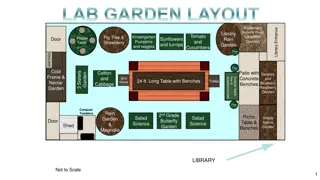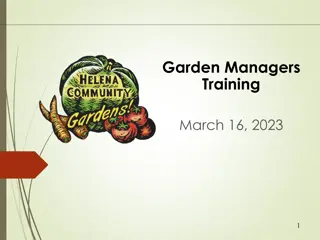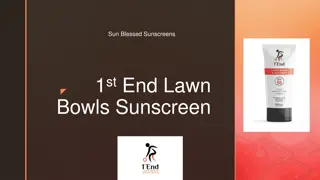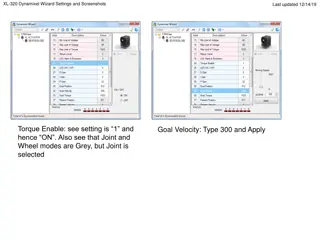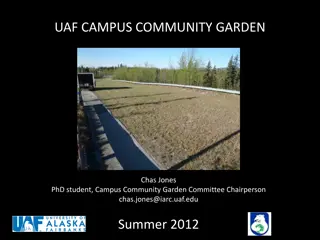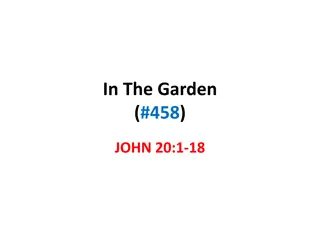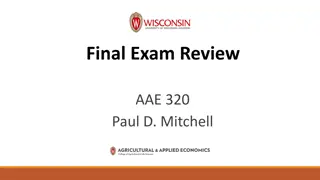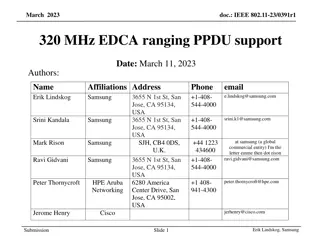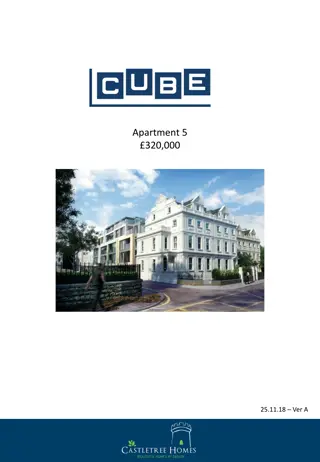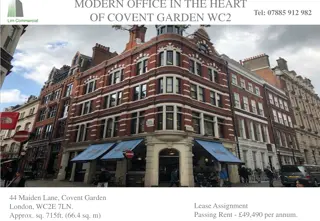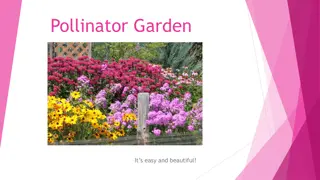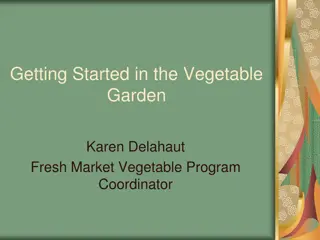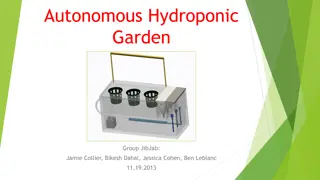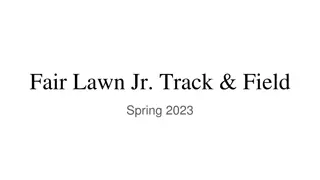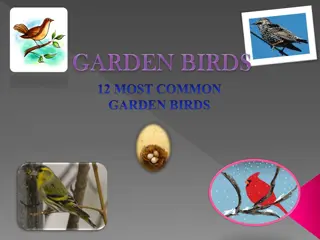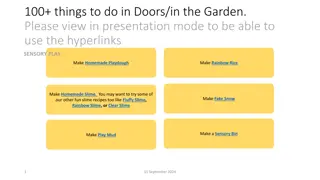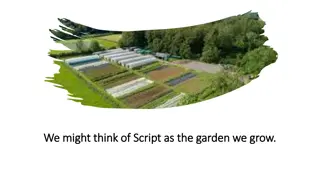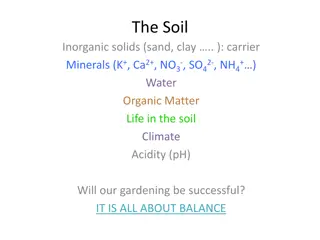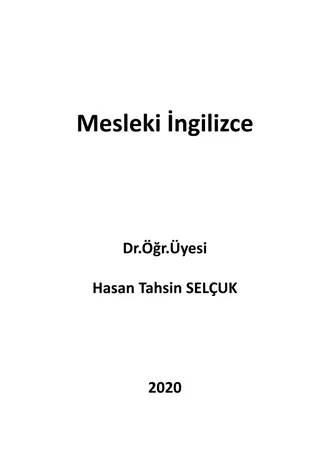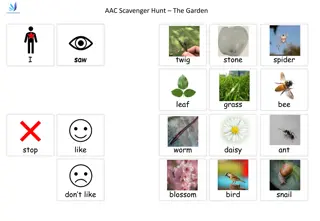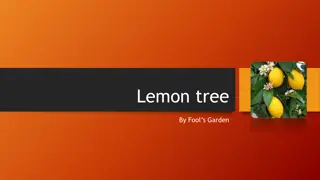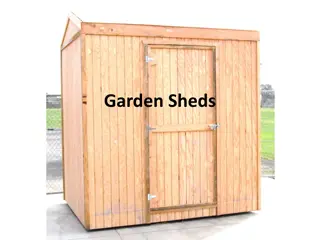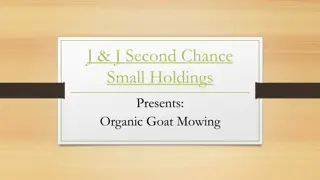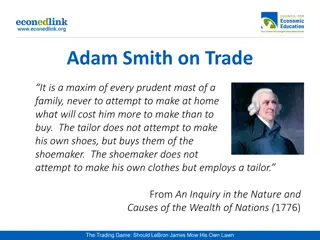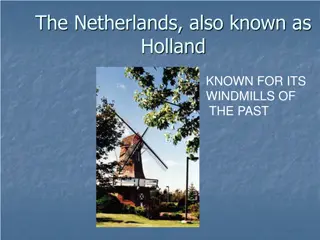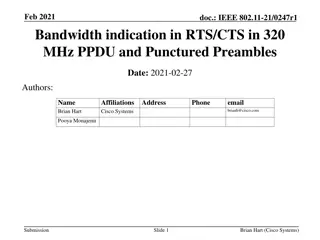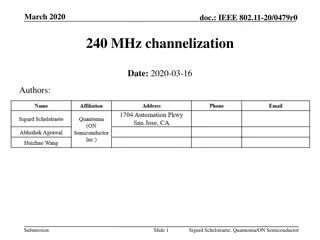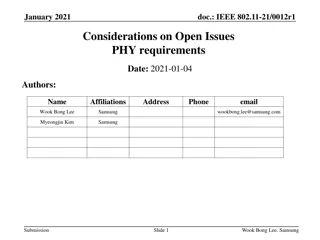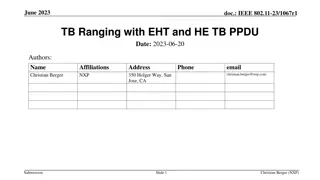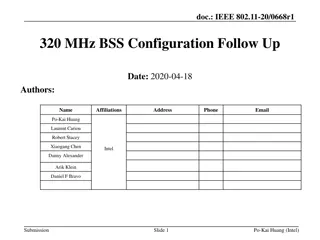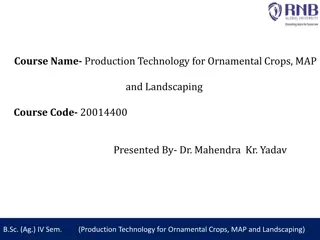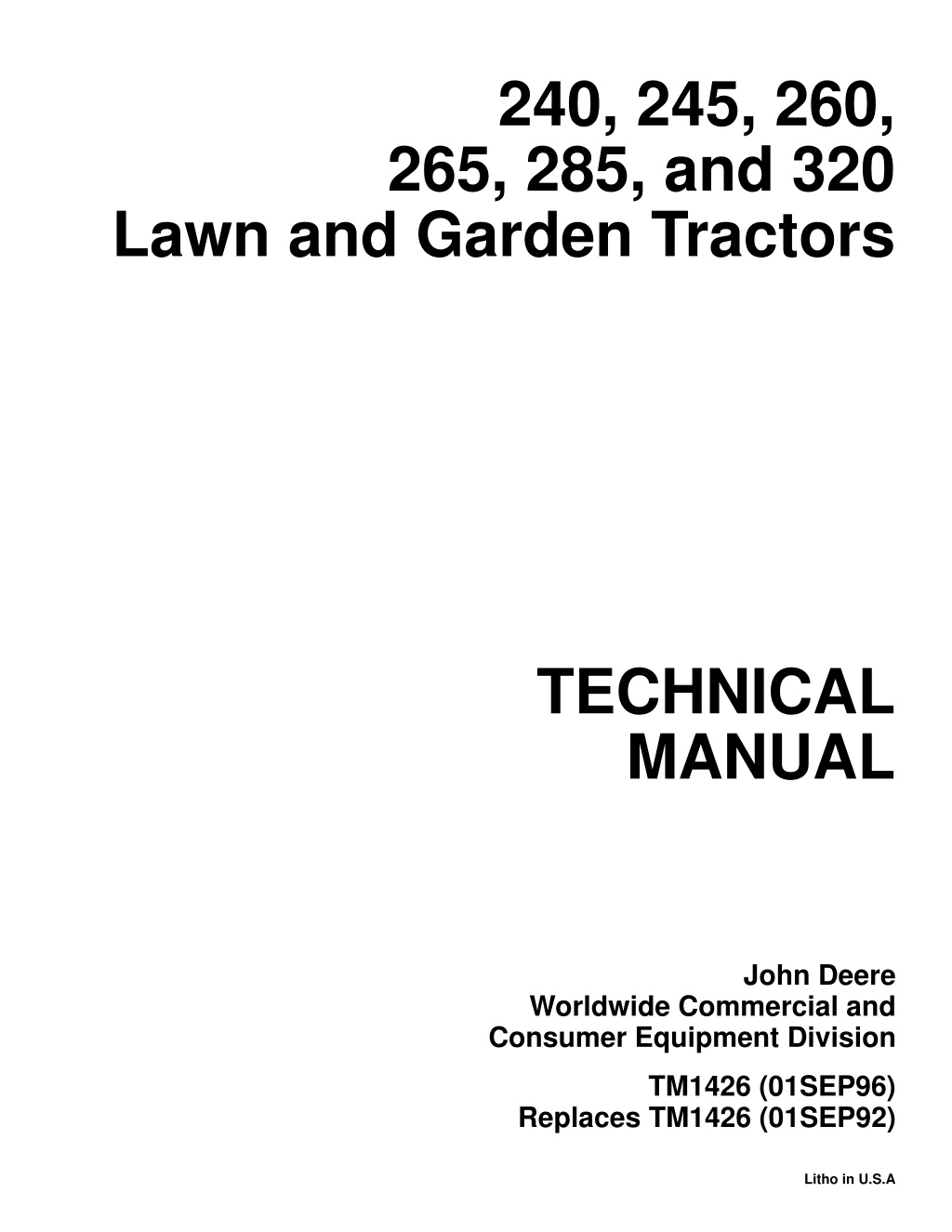
JOHN DEERE 320 LAWN AND GARDEN TRACTOR Service Repair Manual Instant Download (TM1426)
Please open the website below to get the complete manualnn// n
Download Presentation

Please find below an Image/Link to download the presentation.
The content on the website is provided AS IS for your information and personal use only. It may not be sold, licensed, or shared on other websites without obtaining consent from the author. Download presentation by click this link. If you encounter any issues during the download, it is possible that the publisher has removed the file from their server.
E N D
Presentation Transcript
240, 245, 260, 265, 285, and 320 Lawn and Garden Tractors TECHNICAL MANUAL John Deere Worldwide Commercial and Consumer Equipment Division TM1426 (01SEP96) Replaces TM1426 (01SEP92) Litho in U.S.A
INTRODUCTION This technical manual is written for an experienced technician and contains sections that are specifically for this product. It is a part of a total product support program. Safety General Information The manual is organized so that all the information on a particular system is kept together. The order of grouping is as follows: Table of Contents Specifications Component Location System Schematic Theory of Operation Troubleshooting Chart Diagnostics Tests & Adjustments Repair Engine 240/245 (FC420V) Engine 260/265 (FC540V) Engine 285/320 (FD590V) Fuel Injection System 285/320 (FD590V) NOTE: Depending on the particular section or system being covered, not all of the above groups may be used. Electrical Systems Gear Power Train 240/260 Each section will be identified with a symbol rather than a number. The groups and pages within a section will be consecutively numbered. Hydrostatic Power Train 245/265/285/320 All information, illustrations and specifications in this manual are based on the latest information available at the time of publication. The right is reserved to make changes at any time without notice. Steering Hydraulics We appreciate your input on this manual. To help, there are postage paid post cards included at the back. If you find any errors or want to comment on the layout of the manual please fill out one of the cards and mail it back to us. Miscellaneous Repair Index COPYRIGHT 1995 JOHN DEERE HORICON WORKS Horicon, Wisconsin All rights reserved i 9/26/96
CONTENTS SAFETY CONTENTS Page SAFETY . . . . . . . . . . . . . . . . . . . . . . . . . . . . . . . . . . . . . . . . . . . . . . . . .1-2 RECOGNIZE SAFETY INFORMATION . . . . . . . . . . . . . . . . . . . . . . . . . . . . . . . . . 1-2 UNDERSTAND SIGNAL WORDS . . . . . . . . . . . . . . . . . . . . . . . . . . . . . . . . . . . . . 1-2 FOLLOW SAFETY INSTRUCTIONS . . . . . . . . . . . . . . . . . . . . . . . . . . . . . . . . . . . 1-2 HANDLE FLUIDS SAFELY - AVOID FIRES . . . . . . . . . . . . . . . . . . . . . . . . . . . . . . 1-2 PREVENT BATTERY EXPLOSIONS . . . . . . . . . . . . . . . . . . . . . . . . . . . . . . . . . . . 1-3 PREPARE FOR EMERGENCIES . . . . . . . . . . . . . . . . . . . . . . . . . . . . . . . . . . . . . . 1-3 PREVENT ACID BURNS . . . . . . . . . . . . . . . . . . . . . . . . . . . . . . . . . . . . . . . . . . . . 1-3 SERVICE COOLING SYSTEM SAFELY . . . . . . . . . . . . . . . . . . . . . . . . . . . . . . . . 1-4 AVOID HIGH-PRESSURE FLUIDS . . . . . . . . . . . . . . . . . . . . . . . . . . . . . . . . . . . . 1-4 PARK MACHINE SAFELY . . . . . . . . . . . . . . . . . . . . . . . . . . . . . . . . . . . . . . . . . . . 1-4 SUPPORT MACHINE PROPERLY . . . . . . . . . . . . . . . . . . . . . . . . . . . . . . . . . . . . 1-4 WEAR PROTECTIVE CLOTHING . . . . . . . . . . . . . . . . . . . . . . . . . . . . . . . . . . . . . 1-5 WORK IN CLEAN AREA . . . . . . . . . . . . . . . . . . . . . . . . . . . . . . . . . . . . . . . . . . . . 1-5 SERVICE MACHINES SAFELY . . . . . . . . . . . . . . . . . . . . . . . . . . . . . . . . . . . . . . . 1-5 WORK IN VENTILATED AREA . . . . . . . . . . . . . . . . . . . . . . . . . . . . . . . . . . . . . . . 1-5 ILLUMINATE WORK AREA SAFELY . . . . . . . . . . . . . . . . . . . . . . . . . . . . . . . . . . . 1-6 REPLACE SAFETY SIGNS . . . . . . . . . . . . . . . . . . . . . . . . . . . . . . . . . . . . . . . . . . 1-6 USE PROPER LIFTING EQUIPMENT . . . . . . . . . . . . . . . . . . . . . . . . . . . . . . . . . . 1-6 SERVICE TIRES SAFELY . . . . . . . . . . . . . . . . . . . . . . . . . . . . . . . . . . . . . . . . . . . 1-6 AVOID HEATING NEAR PRESSURIZED FLUID LINES . . . . . . . . . . . . . . . . . . . . 1-7 REMOVE PAINT BEFORE WELDING OR HEATING . . . . . . . . . . . . . . . . . . . . . . 1-7 USE PROPER TOOLS . . . . . . . . . . . . . . . . . . . . . . . . . . . . . . . . . . . . . . . . . . . . . . 1-7 DISPOSE OF WASTE PROPERLY . . . . . . . . . . . . . . . . . . . . . . . . . . . . . . . . . . . . 1-7 LIVE WITH SAFETY . . . . . . . . . . . . . . . . . . . . . . . . . . . . . . . . . . . . . . . . . . . . . . . . 1-8 1 - 1 7/26/96
https://www.ebooklibonline.com Hello dear friend! Thank you very much for reading. Enter the link into your browser. The full manual is available for immediate download. https://www.ebooklibonline.com
SAFETY SAFETY FOLLOW SAFETY INSTRUCTIONS RECOGNIZE SAFETY INFORMATION TS201 Carefully read all safety messages in this manual and on your machine safety signs. Keep safety signs in good condition. Replace missing or damaged safety signs. Be sure new equipment components and repair parts include the current safety signs. Replacement safety signs are available from your John Deere dealer. Learn how to operate the machine and how to use controls properly. DO NOT let anyone operate without instruction. Keep your machine in proper working condition. Unauthorized modifications to the machine may impair the function and/or safety and affect machine life. If you DO NOT understand any part of this manual and need assistance, contact your John Deere dealer. T81389 This is the safety-alert symbol. When you see this symbol on your machine or in this manual, be alert to potential for personal injury. Follow recommended precautions and safe operating practices. UNDERSTAND SIGNAL WORDS HANDLE FLUIDS SAFELY - AVOID FIRES TS187 A signal word - DANGER, WARNING, or CAUTION - is used with the safety-alert symbol. DANGER identifies the most serious hazards. DANGER or WARNING safety signs are located near specific hazards. General precautions are listed on CAUTION safety signs. CAUTION also call attention to safety messages in this manual. TS227 When you work around fuel, DO NOT smoke or work near heaters or other fire hazards. Store flammable fluids away from fire hazards. DO NOT incinerate or puncture pressurized containers. Make sure machine is clean of trash, grease, and debris. DO NOT store oily rages; they can ignite and burn spontaneously. 1 - 2 9/26/96
SAFETY PREVENT BATTERY EXPLOSIONS PREVENT ACID BURNS TS204 Keep sparks, lighted matches, and open flame away from the top of battery. Battery gas can explode. Never check battery charges by placing a metal object across the posts. Use a volt-meter or hydrometer. DO NOT charge a frozen battery; it may explode. Warm battery to 16 C (60 F). PREPARE FOR EMERGENCIES TS203 Sulfuric acid in battery electrolyte is poisonous. It is strong enough to burn skin, eat holes in clothing, and cause blindness if splashed into eyes. Avoid the hazard by: 1. Filling batteries in a well-ventilated area. 2. Wearing eye protection and rubber gloves. 3. Avoiding breathing fumes when electrolyte is added. 4. Avoiding spilling or dripping electrolyte. 5. Use proper jump start procedure. TS291 Be prepared if a fire starts. Keep a first aid kit and fire extinguisher handy. Keep emergency numbers for doctors, ambulance service, hospital, and fire department near your telephone. If you spill acid on yourself: 1. Flush your skin with water. 2. Apply baking soda or lime to help neutralize the acid. 3. Flush your eyes with water for 10 15 minutes. Get medical attention immediately. If acid is swallowed: 1. Drink large amounts of water or milk. 2. Then drink milk of magnesia, beaten eggs, or vegetable oil. 3. Get medical attention immediately. 1 - 3 9/26/96
SAFETY SERVICE COOLING SYSTEM SAFELY PARK MACHINE SAFELY TS230 TS281 Before working on the machine: Lower all equipment to the ground. Stop the engine and remove the key. Disconnect the battery ground strap. Hang a DO NOT OPERATE tag in operator station. Explosive release of fluids from pressurized cooling system can cause serious burns. Shut off engine. Only remove filler cap when cool enough to touch with bare hands. Slowly loosen cap to first stop to relieve pressure before removing completely. SUPPORT MACHINE PROPERLY AVOID HIGH-PRESSURE FLUIDS TS229 X9811 Always lower the attachment or implement to the ground before you work on the machine. If you must work on a lifted machine or attachment, securely support the machine or attachment. DO NOT support the machine on cinder blocks. hollow tiles, or props that may crumble under continuous load. DO NOT work under the machine that is supported solely by a jack. Follow recommended procedures in this manual. Escaping fluid under pressure can penetrate the skin causing serious injury. Avoid the hazard by relieving pressure before disconnecting hydraulic or other lines. Tighten all connections before applying pressure. Search for leaks with a piece of cardboard. Protect hands and body from high pressure fluids. If an accident occurs, see a doctor immediately. Any fluid injected into the skin must be surgically removed within a few hours or gangrene may result. Doctors unfamiliar with this type of injury should reference a knowledgeable medical source. Such information is available from Deere & Company Medical Department in Moline, Illinois, U.S.A. 1 - 4 9/26/96
SAFETY WEAR PROTECTIVE CLOTHING SERVICE MACHINES SAFELY TS228 TS206 Tie long hair behind your head. DO NOT wear a necktie, scarf, loose clothing, or necklace when you work near machine tools or moving parts. If these items were to get caught, severe injury could result. Remove rings and other jewelry to prevent electrical shorts and entanglement in moving parts. Wear close fitting clothing and safety equipment appropriate to the job. Prolonged exposure to loud noise can cause impairment or loss of hearing. Wear a suitable hearing protective device such as earmuffs or earplugs to protect against objectionable or uncomfortable loud noises. Operating equipment safely requires the full attention of the operator. DO NOT wear radio or music headphones while operating machine. WORK IN VENTILATED AREA WORK IN CLEAN AREA TS220 WARNING: California Proposition 65 Warning Gasoline engine exhaust from this product contains chemicals known to the State of California to cause cancer, birth defects, or other reproductive harm. Engine exhaust fumes can cause sickness or death. If it is necessary to run an engine in an enclosed area, remove the exhaust fumes from the area with an exhaust pipe extension. If you DO NOT have an exhaust pipe extension, open the doors and get outside air into the area. T6642EJ Before starting a job: Clean work area and machine. Make sure you have all necessary tools to do your job. Have the right parts on hand. Read all instructions thoroughly; DO NOT attempt shortcuts. 1 - 5 9/26/96
SAFETY ILLUMINATE WORK AREA SAFELY USE PROPER LIFTING EQUIPMENT TS223 TS226 Illuminate your work area adequately but safely. Use a portable safety light for working inside or under the machine. Make sure the bulb is enclosed by a wire cage. The hot filament of an accidentally broken bulb can ignite spilled fuel or oil. Lifting heavy components incorrectly can cause severe injury or machine damage. Follow recommended procedure for removal and installation of components in the manual. SERVICE TIRES SAFELY REPLACE SAFETY SIGNS TS952 TS201 Explosive separation of a tire and rim parts can cause serious injury or death. DO NOT attempt to mount a tire unless you have the proper equipment and experience to perform the job. Always maintain the correct tire pressure. DO NOT inflate the tires above the recommended pressure. Never weld or heat a wheel and tire assembly. The heat can cause an increase in air pressure resulting in a tire explosion. Welding can structurally weaken or deform the wheel. When inflating tires, use a clip-on chuck and extension hose long enough to allow you to stand to one side and NOT in front of or over the tire assembly. Use a safety cage if available. Check wheels for low pressure, cuts, bubbles, damaged rims or missing lug bolts and nuts. Replace missing or damaged safety signs. See the machine operator's manual for correct safety sign placement. 1 - 6 9/26/96
SAFETY AVOID HEATING NEAR PRESSURIZED FLUID LINES If you use solvent or paint stripper, remove stripped with soap and water before welding. Remove solvent or paint stripper containers and other flammable material from area. Allow fumes to disperse at least 15 minutes before welding or heating. USE PROPER TOOLS TS953 Flammable spray can be generated by heating near pressurized fluid lines, resulting in severe burns to yourself and bystanders. DO NOT heat by welding, soldering, or using a torch near pressurized fluid lines or other flammable materials. Pressurized lines can be accidentally cut when heat goes beyond the immediate flame area. TS779 Use tools appropriate to the work. Makeshift tools and procedures can create safety hazards. Use power tools only to loosen threaded parts and fasteners. For loosening and tightening hardware, use the correct size tools. DO NOT use U.S. measurement tools on metric fasteners. Avoid bodily injury caused by slipping wrenches. Use only service parts meeting John Deere specifications. REMOVE PAINT BEFORE WELDING OR HEATING DISPOSE OF WASTE PROPERLY TS220 Avoid potentially toxic fumes and dust. Hazardous fumes can be generated when paint is heated by welding, soldering, or using a torch. Do all work outside or in a well ventilated area. Dispose of paint and solvent properly. Remove paint before welding or heating. TS1133 Improperly disposing of waste can threaten the environment and ecology. Potentially harmful waste used with John Deere equipment include such items as oil, fuel, coolant, brake fluid, filters, and batteries. If you sand or grind paint, avoid breathing the dust. Wear an approved respirator. 1 - 7 9/26/96
SAFETY Use leakproof containers when draining fluids. DO NOT use food or beverage containers that may mislead someone into drinking from them. DO NOT pour waste onto the ground, down a drain, or into any water source. Air conditioning refrigerants escaping into the air can damage the Earth's atmosphere. regulations may require a certified air conditioning service center to recover and recycle used air conditioning refrigerants. Inquire on the proper way to recycle or dispose of waste from your local environmental or recycling center, or from your John Deere dealer. Government LIVE WITH SAFETY TS231 Before returning machine to customer, make sure machine is functioning properly, especially the safety systems. Install all guards and shields. 1 - 8 9/26/96
CONTENTS GENERAL INFORMATION CONTENTS Page GENERAL SPECIFICATIONS . . . . . . . . . . . . . . . . . . . . . . . . . . . . . . . .2-3 MACHINE SPECIFICATIONS. . . . . . . . . . . . . . . . . . . . . . . . . . . . . . . . . . . . . . . . . 2-3 TEST AND ADJUSTMENT SPECIFICATIONS. . . . . . . . . . . . . . . . . . . . . . . . . . . . 2-7 SERVICE RECOMMENDATIONS. . . . . . . . . . . . . . . . . . . . . . . . . . . . . . . . . . . . . . 2-9 METRIC FASTENER TORQUE VALUES. . . . . . . . . . . . . . . . . . . . . . .2-11 INCH FASTENER TORQUE VALUES . . . . . . . . . . . . . . . . . . . . . . . . .2-12 GASOLINE SPECIFICATIONS. . . . . . . . . . . . . . . . . . . . . . . . . . . . . . .2-13 GASOLINE STORAGE . . . . . . . . . . . . . . . . . . . . . . . . . . . . . . . . . . . . . . . . . . . . . 2-13 4 CYCLE ENGINES - EUROPE. . . . . . . . . . . . . . . . . . . . . . . . . . . . . . . . . . . . . . 2-14 GASOLINE STORAGE . . . . . . . . . . . . . . . . . . . . . . . . . . . . . . . . . . . . . . . . . . . . . 2-14 4 CYCLE GASOLINE ENGINE OIL - NORTH AMERICA . . . . . . . . . . . . . . . . . . 2-15 4 CYCLE GASOLINE ENGINE OIL - EUROPE . . . . . . . . . . . . . . . . . . . . . . . . . . 2-16 4 CYCLE GASOLINE ENGINE OIL - EUROPE . . . . . . . . . . . . . . . . . . . . . . . . . . 2-17 BREAK IN 4-CYCLE GASOLINE ENGINE OIL - EUROPE . . . . . . . . . . . . . . . . . 2-18 GEAR CASE OIL - NORTH AMERICA . . . . . . . . . . . . . . . . . . . . . . . . . . . . . . . . . 2-19 GEAR CASE OIL - EUROPE . . . . . . . . . . . . . . . . . . . . . . . . . . . . . . . . . . . . . . . . 2-20 GEAR TRANSMISSION GREASE - NORTH AMERICA. . . . . . . . . . . . . . . . . . . . 2-21 GEAR TRANSMISSION GREASE - EUROPE . . . . . . . . . . . . . . . . . . . . . . . . . . . 2-22 GREASE SPECIFICATIONS. . . . . . . . . . . . . . . . . . . . . . . . . . . . . . . . .2-23 GREASE - NORTH AMERICA . . . . . . . . . . . . . . . . . . . . . . . . . . . . . . . . . . . . . . . 2-23 GREASE - EUROPE . . . . . . . . . . . . . . . . . . . . . . . . . . . . . . . . . . . . . . . . . . . . . . . 2-24 ALTERNATIVE LUBRICANTS. . . . . . . . . . . . . . . . . . . . . . . . . . . . . . . . . . . . . . . . 2-25 SYNTHETIC LUBRICANTS . . . . . . . . . . . . . . . . . . . . . . . . . . . . . . . . . . . . . . . . 2-25 LUBRICANT STORAGE. . . . . . . . . . . . . . . . . . . . . . . . . . . . . . . . . . . . . . . . . . . 2-25 MIXING OF LUBRICANTS. . . . . . . . . . . . . . . . . . . . . . . . . . . . . . . . . . . . . . . . . 2-25 OIL FILTERS . . . . . . . . . . . . . . . . . . . . . . . . . . . . . . . . . . . . . . . . . . . . . . . . . . . 2-25 ALTERNATIVE LUBRICANTS. . . . . . . . . . . . . . . . . . . . . . . . . . . . . . . . . . . . . . . . 2-26 SYNTHETIC LUBRICANTS . . . . . . . . . . . . . . . . . . . . . . . . . . . . . . . . . . . . . . . . 2-26 LUBRICANT STORAGE. . . . . . . . . . . . . . . . . . . . . . . . . . . . . . . . . . . . . . . . . . . 2-26 MIXING OF LUBRICANTS . . . . . . . . . . . . . . . . . . . . . . . . . . . . . . . . . . . . . . . . . . 2-26 OIL FILTERS . . . . . . . . . . . . . . . . . . . . . . . . . . . . . . . . . . . . . . . . . . . . . . . . . . . . . 2-26 COOLANT SPECIFICATIONS . . . . . . . . . . . . . . . . . . . . . . . . . . . . . . .2-27 DIESEL AND GASOLINE ENGINE COOLANT - NORTH AMERICA . . . . . . . . . . 2-27 DIESEL AND GASOLINE ENGINE COOLANT DRAIN INTERVAL - NORTH AMERICA . . . . . . . . . . . . . . . . . . . . . . . . . . . . . . . . . . . . . . . . . . . . . . . 2-27 GASOLINE ENGINE COOLANT - EUROPE. . . . . . . . . . . . . . . . . . . . . . . . . . . . . 2-28 GASOLINE ENGINE COOLANT DRAIN INTERVAL - EUROPE . . . . . . . . . . . . . 2-28 2 - 1 9/26/96
CONTENTS CONTINUED Page SERIAL NUMBER LOCATIONS . . . . . . . . . . . . . . . . . . . . . . . . . . . . . 2-29 SERIAL NUMBERS . . . . . . . . . . . . . . . . . . . . . . . . . . . . . . . . . . . . . . . . . . . . . . . .2-29 LOCATIONS. . . . . . . . . . . . . . . . . . . . . . . . . . . . . . . . . . . . . . . . . . . . . . . . . . . . . .2-29 PRODUCT IDENTIFICATION NUMBER LOCATION. . . . . . . . . . . . . . . . . . . . . . .2-29 ENGINE SERIAL NUMBER LOCATION . . . . . . . . . . . . . . . . . . . . . . . . . . . . . . . .2-29 HYDROSTATIC TRANSMISSION SERIAL NUMBER LOCATION - 245/265/285/320. . . . . . . . . . . . . . . . . . . . . . . . . . . . . . . . . . . . . . . . . . . . . . . . .2-29 HYDRAULIC LIFT VALVE SERIAL NUMBER LOCATION - 320 . . . . . . . . . . . . . .2-29 OPERATIONAL CHECKOUT PROCEDURE . . . . . . . . . . . . . . . . . . . 2-30 BEFORE YOU START . . . . . . . . . . . . . . . . . . . . . . . . . . . . . . . . . . . . . . . . . . . . . .2-30 BRAKE PEDAL LOCK CHECK . . . . . . . . . . . . . . . . . . . . . . . . . . . . . . . . . . . . . . .2-30 INDICATOR LAMP CHECK - ENGINE OFF . . . . . . . . . . . . . . . . . . . . . . . . . . . . .2-31 TRANSMISSION NEUTRAL START CHECK . . . . . . . . . . . . . . . . . . . . . . . . . . . .2-31 PTO/SAFETY START CHECK. . . . . . . . . . . . . . . . . . . . . . . . . . . . . . . . . . . . . . . .2-32 STARTING CIRCUIT CHECK - HYDROSTATIC TRACTORS . . . . . . . . . . . . . . . .2-32 STARTING CIRCUIT CHECK - GEAR TRACTORS . . . . . . . . . . . . . . . . . . . . . . .2-32 INDICATOR LAMP CHECK - ENGINE RUNNING. . . . . . . . . . . . . . . . . . . . . . . . .2-33 THROTTLE AND CHOKE LEVER CHECK - ENGINE RUNNING. . . . . . . . . . . . .2-33 PTO CLUTCH CHECK. . . . . . . . . . . . . . . . . . . . . . . . . . . . . . . . . . . . . . . . . . . . . .2-34 SEAT SWITCH CHECK - PTO AND IGNITION . . . . . . . . . . . . . . . . . . . . . . . . . . .2-34 TRANSMISSION FORWARD AND REVERSE CHECK . . . . . . . . . . . . . . . . . . . .2-34 TRANSMISSION NEUTRAL CREEP CHECK - HYDROSTATIC TRACTORS. . . .2-35 BRAKE NEUTRAL RETURN CHECK - HYDROSTATIC TRACTORS. . . . . . . . . .2-35 HEADLIGHT CHECK . . . . . . . . . . . . . . . . . . . . . . . . . . . . . . . . . . . . . . . . . . . . . . .2-36 HYDRAULIC LIFT SYSTEM CHECK. . . . . . . . . . . . . . . . . . . . . . . . . . . . . . . . . . .2-36 2 - 2 9/26/96
GENERAL SPECIFICATIONS GENERAL INFORMATION GENERAL SPECIFICATIONS MACHINE SPECIFICATIONS Model: 240 245 260 ENGINE Manufacturer Model number Horsepower Type of Valves Type of Cooling Kawasaki FC420V 14 (10.4 kW) Overhead Air Kawasaki FC420V 14 (10.4 kW) Overhead Air Kawasaki FC540V 17 (12.6kW) Overhead Air Number of Cylinders Crankshaft Alignment Stroke/Cycle Bore Stroke Displacement One Vertical Four 89 mm (3.5 in.) 68 mm (2.7 in.) 423 cm3 (25.8 cu. in.) 8.4:1 3350 100 rpm 1450 75 rpm Dry, Replaceable Foam Pre-Cleaner One Vertical Four 89 mm (3.5 in) 68 mm (2.7 in.) 423 cm3 (25.8 cu. in.) 8.4:1 3350 100 rpm 1450 75 rpm Dry, Replaceable Foam Pre-Cleaner One Vertical Four 89 mm (3.5 in.) 86 mm (3.38 in.) 535 cm3 (32.6 cu. in.) 8.3:1 3350 100 rpm 1450 75 rpm Dry, Replaceable Foam Pre-Cleaner Compression Ratio Fast Idle (no load) Slow Idle (no load) Air Filter Crankcase Capacity with Filter 1.5 L (3.17 U.S. pt) Optional 1.5 L (3.17 U.S. pt) Optional 1.9 L (4.0 U.S. pt) Standard Replaceable Oil Filter ELECTRICAL SYSTEM Charging System Capacity Battery Type Battery Voltage Battery Reserve Capacity at 25 Amp. Battery Cold Cranking Amp. at 0 F Stator 14 Amp. Reg. BCI Group, U1 12 Volts Stator 14 Amp. Reg. BCI Group, U1 12 Volts Stator 16 Amp. Reg. BCI Group, U1 12 Volts 41 Min. 60 Min. 41 Min. 340 Amp. 335 Amp. 340 Amp. FUEL SYSTEM Fuel Tank Capacity Fuel Type Fuel Filter 11.4 L (3.0 gal) Unleaded Gasoline Replaceable In Line 11.4 L (3.0 gal) Unleaded Gasoline Replaceable In Line 11.4 L (3.0 gal) Unleaded Gasoline Replaceable In Line 2 - 3 9/26/96
GENERAL SPECIFICATIONS GENERAL INFORMATION MACHINE SPECIFICATIONS (CONTINUED) Model: POWER TRAIN Transmission Manufacturer Lubricant* S/N(130001- 240 245 260 Gear Transaxle Kanzaki J20D Low Viscosity HY-GARD 3.8 L (1 U.S. gal) Hydrostatic Sundstrand J20D Low Viscosity HY-GARD 2.5 L (2.6 U.S. qt) Gear Transaxal Kanzaki J20D Low Viscosity HY-GARD 3.8 L (1 U.S. gal) ) Capacity *DO NOT mix oils when adding oil, make sure color of add lubricant matches existing oil. Model: 265 285/320 ENGINE Manufacturer Model Number Horsepower Type of Valves Type of Cooling Number of Cylinders Crankshaft Alignment Stroke/Cycle Bore Stroke Displacement Kawasaki FC540V 17 (12.6kW) Overhead Air One Vertical Four 89 mm (3.5 in.) 86 mm (3.36 in.) 535 cm3 (32.6 cu. in.) 8.3:1 3350 100 rpm 1550 75 rpm Dry, Replaceable Foam Pre-Cleaner 1.8 L (3.8 pt.) Standard N/A Kawasaki FD590V 18 (13.4kW) Overhead Liquid Two Vertical Four 74 mm (2.9 in.) 68 mm (2.7 in.) 585 cm3 (35.7 cu. in.) 8.7:1 3350 100 rpm 1550 75 rpm Dry, Replaceable Foam Pre-Cleaner 1.9 L (4.0 pt.) Standard 3.1 L (3.3 U.S. Qt.) Compression Ratio Fast Idle (no load) Slow Idle (no load) Air Filter Crankcase Capacity with Filter Replaceable Oil Filter Coolant Capacity ELECTRICAL SYSTEM Charging System Capacity Battery Type Battery Voltage Batter Reserve Capacity at 25 Amp. Battery Cold Cranking Amp. at 0 F Stator 16 Amp. Reg. BCI Group, 22F 12 Volts Stator 16 Amp. Reg. BCI Group, 22F 12 Volts 60 Min. 60 Min. 335 Amp. 335 Amp. 2 - 4 9/26/96
GENERAL SPECIFICATIONS GENERAL INFORMATION MACHINE SPECIFICATIONS (CONTINUED) Model: FUEL SYSTEM Fuel Tank Capacity 265 285/320 11.4 L (3.0 Gal.) (Regular Leaded or 11.4 L (3.0 Gal.) (Regular Leaded or Unleaded Gasoline) Replaceable In Line Unleaded Gasoline) Replaceable In Line Fuel Filter POWER TRAIN Transmission Manufacturer Lubricant* Hydrostatic Sundstrand Low Viscosity HY-GARD J20D 2.5 L (2.6 U.S. qt.) Hydrostatic Sundstrand Low Viscosity HY-GARD J20D 2.5 L (2.6 U.S. qt.) S/N(130001- Specification Capacity ) *DO NOT mix oils when adding oil, make sure color of add lubricant matches existing oil. CHASSIS DIMENSIONS Wheelbase ...................................................................................................................................... 122 cm (47.9 in.) Overall Length.................................................................................................................................. 182 cm (71.5 in.) With Read Bagger ............................................................................................................................2.37 m (93.5 in.) With Front Quick-Thatch Wts. ....................................................................................................2.02 m (79.5 in.) With Rear Quick-Thatch Wts.........................................................................................................1.93 m (76 in.) Overall Height ...................................................................................................................................111 cm (43.6 in.) Overall Width Min. (Tractor Only)...........................................................................................................................1.0 m (39 in.) Max. (Tractor Only).......................................................................................................................1.1 m (41.5 in.) With 38 in. Mower: Deflector Up ............................................................................................................................ 104 cm (41 in.) Deflector Down .................................................................................................................... 136 cm (53.5 in.) With Read Bagger .................................................................................................................... 126 cm (49.5 in.) With 46 in. Mower: Deflector Up.......................................................................................................................... 136 cm (53.5 in.) Deflector Down ....................................................................................................................... 145 cm (57 in.) With 48 in. Mower: Deflector Up.......................................................................................................................... 138 cm (54.5 in.) Deflector Down .................................................................................................................... 157 cm (62.0 in.) With 50 in. Mower: Deflector Up.......................................................................................................................... 144 cm (56.5 in.) Deflector Down ....................................................................................................................... 155 cm (61 in.) 2 - 5 9/26/96
GENERAL SPECIFICATIONS GENERAL INFORMATION CHASSIS DIMENSIONS (CONTINUED) OVERALL WIDTH (CONTINUED) Turning Radius Inside Read Wheel......................................................................................................................... 64 cm (25 in.) Outside Read Wheel .................................................................................................................... 203 cm (80 in.) Wheel Tread Front............................................................................................................................................ 80 cm (31.5 in.) Rear (320) ...................................................................................................................................... 74 cm (29 in.) TIRES Type Front...............................................................................................................................................................Turf Rear..................................................................................................................................................... Turf or Bar Size Front..................................................................................................................................................... 16 x 6.5-8 Rear.................................................................................................................................................. 23 x 10.5-12 Inflation Pressure Front Front...........................................................................................................................32070 - 97 kPa (10-14 psi) Rear....................................................................................................................................40 - 70 kPa (6-10 psi) All (except 32070) - 110 kPa (10-16 psi) BRAKES (S.N. (S.N. 130001 - - 130000)...........................................................................................................Expanding Shoe ) ....................................................................................................................Wet Disc PTO CLUTCH Type...........................................................................................................................................................Electric IMPLEMENT LIFT All (except 320)........................................................................Manual W/Depth Stop and Adjustable Lift Spring 320........................................................................................Hydraulic W/Depth Stop and Adjustable Lift Spring (Specification and design subject to change without notice.) 2 - 6 9/26/96
GENERAL SPECIFICATIONS GENERAL INFORMATION TEST AND ADJUSTMENT SPECIFICATIONS ITEM SPECIFICATION ENGINE Fast Idle (except fuel injected 285) . . . . . . . . . . . . . . . . . . . . . . . . . . . . . . . . . . . . . . . . . . . . . . . . . . .3350 50 rpm Slow Idle . . . . . . . . . . . . . . . . . . . . . . . . . . . . . . . . . . . . . . . . . . . . . . . . . . . . . . . . . . . . . . . . . . . . . . .1450 75 rpm Compression (Min.) 240, 245, 260, 265. . . . . . . . . . . . . . . . . . . . . . . . . . . . . . . . . . . . . . . . . . . . . . . . . . . . . . . . . . . . . 483 kPa (71 psi) 285, 320. . . . . . . . . . . . . . . . . . . . . . . . . . . . . . . . . . . . . . . . . . . . . . . . . . . . . . . . . . . . . . . . . . . . . 588 kPa (85 psi) Intake and Exhaust Valve Clearance (Cold) 240, 245, 260, 265. . . . . . . . . . . . . . . . . . . . . . . . . . . . . . . . . . . . . . . . . . . . . . . . . . . . . . . . . . .0.15 mm (0.006 in.) 285, 320. . . . . . . . . . . . . . . . . . . . . . . . . . . . . . . . . . . . . . . . . . . . . . . . . . . . . . . . . . . . . . . . . . . .0.25 mm (0.01 in.) Crankcase Vacuum (Min.) 240, 245, 260, 265. . . . . . . . . . . . . . . . . . . . . . . . . . . . . . . . . . . . . . . . . . . . . . . . . . . . . . . . . . .25 cm (10 in. water) 285, 320. . . . . . . . . . . . . . . . . . . . . . . . . . . . . . . . . . . . . . . . . . . . . . . . . . . . . . . . . . . . . . . . . . . .18 cm (7 in. water) Oil Pressure (Min.). . . . . . . . . . . . . . . . . . . . . . . . . . . . . . . . . . . . . . . . . . . . . . . . . . . . . . . . . . . . . . 240 kPa (35 psi) Fuel Pump Pressure (Min.) 240, 245, 260, 265. . . . . . . . . . . . . . . . . . . . . . . . . . . . . . . . . . . . . . . . . . . . . . . . . . . . . . . . . . . . . . .6 kPa (0.9 psi) 285, 320. . . . . . . . . . . . . . . . . . . . . . . . . . . . . . . . . . . . . . . . . . . . . . . . . . . . . . . . . . . . . . . . . . . . . .19 kPa (2.8 psi) Fuel Pump Flow (Min.) 240, 245. . . . . . . . . . . . . . . . . . . . . . . . . . . . . . . . . . . . . . . . . . . . . . . . . . . . . . . . . . 80 ml/15 sec. (2.7 oz./15 sec.) 260, 265. . . . . . . . . . . . . . . . . . . . . . . . . . . . . . . . . . . . . . . . . . . . . . . . . . . . . . . . . . . .90 ml/15 sec. (3 oz./15 sec.) 285, 320. . . . . . . . . . . . . . . . . . . . . . . . . . . . . . . . . . . . . . . . . . . . . . . . . . . . . . . . . 160 ml/15 sec. (5.4 oz./15 sec.) Fuel Pressure - Fuel Injected 285 . . . . . . . . . . . . . . . . . . . . . . . . . . . . . . . . . . . . . . . . . . . . 274-284 kPa (40-41 psi) ELECTRICAL Regulated Voltage Output 240, 245. . . . . . . . . . . . . . . . . . . . . . . . . . . . . . . . . . . . . . . . . . . . . . . . . . . . . . . . . . .11 amps (Min.) at 12.2-13.8 V 260, 265. . . . . . . . . . . . . . . . . . . . . . . . . . . . . . . . . . . . . . . . . . . . . . . . . . . . . . . . . . .13 amps (Min.) at 12.2-13.8 V 285, 320. . . . . . . . . . . . . . . . . . . . . . . . . . . . . . . . . . . . . . . . . . . . . . . . . . . . . . . . . . .15 amps (Min.) at 12.1-13.8 V Unregulated Voltage Output (Min.) 240, 245. . . . . . . . . . . . . . . . . . . . . . . . . . . . . . . . . . . . . . . . . . . . . . . . . . . . . . . . . . . . . . . . . . . . . . . . . . . . . . .30 V 260, 265. . . . . . . . . . . . . . . . . . . . . . . . . . . . . . . . . . . . . . . . . . . . . . . . . . . . . . . . . . . . . . . . . . . . . . . . . . . . . . .27 V 285, 320. . . . . . . . . . . . . . . . . . . . . . . . . . . . . . . . . . . . . . . . . . . . . . . . . . . . . . . . . . . . . . . . . . . . . . . . . . . . . . .26 V Stator Resistance 240, 245, 260, 265. . . . . . . . . . . . . . . . . . . . . . . . . . . . . . . . . . . . . . . . . . . . . . . . . . . . . . . . . . . . . . . 0.24-0.4 ohms 285, 320. . . . . . . . . . . . . . . . . . . . . . . . . . . . . . . . . . . . . . . . . . . . . . . . . . . . . . . . . . . . . . . . . . . . . . 0.12-0.19 ohms Starter Amp Draw (Max.) 240, 245. . . . . . . . . . . . . . . . . . . . . . . . . . . . . . . . . . . . . . . . . . . . . . . . . . . . . . . . . . . . . . . . . . 60 amps at 500 rpm 260, 265. . . . . . . . . . . . . . . . . . . . . . . . . . . . . . . . . . . . . . . . . . . . . . . . . . . . . . . . . . . . . . . . . . 85 amps at 500 rpm 285, 320. . . . . . . . . . . . . . . . . . . . . . . . . . . . . . . . . . . . . . . . . . . . . . . . . . . . . . . . . . . . . . . . . . 72 amps at 500 rpm Starter No-Load Amperage (Max.) 240, 245, 285, 320. . . . . . . . . . . . . . . . . . . . . . . . . . . . . . . . . . . . . . . . . . . . . . . . . . . . . . . . . 50 amps at 6000 rpm 260, 265. . . . . . . . . . . . . . . . . . . . . . . . . . . . . . . . . . . . . . . . . . . . . . . . . . . . . . . . . . . . . . . . . 50 amps at 5000 rpm Starter No-Load RPM 240, 245, 285, 320. . . . . . . . . . . . . . . . . . . . . . . . . . . . . . . . . . . . . . . . . . . . . . . . . . . . . . . . . . . . . . . . . . .6000 rpm 260, 265. . . . . . . . . . . . . . . . . . . . . . . . . . . . . . . . . . . . . . . . . . . . . . . . . . . . . . . . . . . . . . . . . . . . . . . . . . .5000 rpm 2 - 7 9/26/96
GENERAL SPECIFICATIONS GENERAL INFORMATION TEST AND ADJUSTMENT SPECIFICATIONS (CONTINUED) ITEM SPECIFICATION ELECTRICAL Ignition Coil Air Gap - 240, 245, 260, 265 . . . . . . . . . . . . . . . . . . . . . . . . . . . . . . . . . . . . . . . . . . .0.3 mm (0.012 in.) Ignition Coil Resistance - 240, 245, 260, 265 Primary Lead and Core . . . . . . . . . . . . . . . . . . . . . . . . . . . . . . . . . . . . . . . . . . . . . . . . . . . . . . . . . . 0.48-0.72 ohms Spark Plug Lead and Core. . . . . . . . . . . . . . . . . . . . . . . . . . . . . . . . . . . . . . . . . . . . . . . . . . . . . . 10.9-16.3 K ohms Pulsar Coil Resistance - 285, 320 . . . . . . . . . . . . . . . . . . . . . . . . . . . . . . . . . . . . . . . . . . . . . . . . . . . . . 85-270 ohms Ignition Coil Resistance - 285, 320 Primary Coil . . . . . . . . . . . . . . . . . . . . . . . . . . . . . . . . . . . . . . . . . . . . . . . . . . . . . . . . . . . . . . . . . . . . . 3.4-4.6 ohms Secondary Coil. . . . . . . . . . . . . . . . . . . . . . . . . . . . . . . . . . . . . . . . . . . . . . . . . . . . . . . . . . . . . . . 10.4-15.5 K ohms Core Insulation Continuity . . . . . . . . . . . . . . . . . . . . . . . . . . . . . . . . . . . . . . . . . . . . . . . . . . . . . . . . . . . . . . . Infinite Spark Plug Gap: 240, 245, 260, 265. . . . . . . . . . . . . . . . . . . . . . . . . . . . . . . . . . . . . . . . . . . . . . . . . . . .0.7-0.8 mm (0.028-0.032 in.) 285, 320. . . . . . . . . . . . . . . . . . . . . . . . . . . . . . . . . . . . . . . . . . . . . . . . . . . . . . . . . . . . . . . . . . . .0.7 mm (0.028 in.) PTO Clutch Amp Draw (Min.). . . . . . . . . . . . . . . . . . . . . . . . . . . . . . . . . . . . . . . . . . . . . . . . . . . . . . . . . . . . . .4 amps PTO Clutch Air Gap Warner . . . . . . . . . . . . . . . . . . . . . . . . . . . . . . . . . . . . . . . . . . . . . . . . . . . . . . . . . . .0.38-0.64 mm (0.015-0.025 in.) Ogura . . . . . . . . . . . . . . . . . . . . . . . . . . . . . . . . . . . . . . . . . . . . . . . . . . . . . . . . . . .0.30-0.51 mm (0.012-0.020 in.) Throttle Sensor Resistance - Fuel Injected 285 Input Terminal. . . . . . . . . . . . . . . . . . . . . . . . . . . . . . . . . . . . . . . . . . . . . . . . . . . . . . . . . . . . . . . . . . 3.3-6.8 K ohms Output Terminal (idle). . . . . . . . . . . . . . . . . . . . . . . . . . . . . . . . . . . . . . . . . . . . . . . . . . . . . . . . . . . . 0.2-0.5 K ohms Throttle Sensor Output Voltage - Fuel Injected 285. . . . . . . . . . . . . . . . . . . . . . . . . . . . . . . . . . . . . . . . . 0.35-0.38 V Air Temperature Sensor Resistance - Fuel Injected 285 . . . . . . . . . . . . . . . . . . . . . . . . . . . . . . . . . . 1.3-7.4 K ohms Coolant Temperature Sensor Resistance - Fuel Injected 285 . . . . . . . . . . . . . . . . . . . . . . . . . . . . . . 1.3-7.4 K ohms Fuel Injector Resistance - Fuel Injected 285 . . . . . . . . . . . . . . . . . . . . . . . . . . . . . . . . . . . . . . . . . . . 11.1-12.9 ohms POWER TRAIN Clutch Pedal Spring Length . . . . . . . . . . . . . . . . . . . . . . . . . . . . . . . . . . . . . . . . . . . . . . . . . . .54-56 mm (2.1-2.2 in.) Belt Guide Clearance Belt Tension and Bellcrank Idler. . . . . . . . . . . . . . . . . . . . . . . . . . . . . . . . . . . . . . . . . . . . . . . .1-5 mm (0.04-0.2 in.) Engine Sheave. . . . . . . . . . . . . . . . . . . . . . . . . . . . . . . . . . . . . . . . . . . . . . . . . . . . . . . . . . . .1-4 mm (0.04-0.16 in.) Hydrostatic Control Lever Tension. . . . . . . . . . . . . . . . . . . . . . . . . . . . . . . . . . . . . . . . . . . . . . . . . . 22-36 N (5-8 lbs) Charge Pressure: 245, 265, 285. . . . . . . . . . . . . . . . . . . . . . . . . . . . . . . . . . . . . . . . . . . . . . . . . . . . . . . . . . . 193-490 kPa (28-71 psi) 320. . . . . . . . . . . . . . . . . . . . . . . . . . . . . . . . . . . . . . . . . . . . . . . . . . . . . . . . . . . . . . . . . . . 276-621 kPa (40-90 psi) BRAKES Brake Lever Rod Washer to Retainer Clearance. . . . . . . . . . . . . . . . . . . . . . . . . . . . . . . . . . . .8-14 mm (0.3-0.5 in.) Brake Rod Cotter Pin to Retainer Clearance 240/260 (130001- ) . . . . . . . . . . . . .22-28 mm (0.8-1.1 in.) 2 - 8 9/26/96
GENERAL SPECIFICATIONS GENERAL INFORMATION SERVICE RECOMMENDATIONS O-RING BOSS FITTING Thread Size N m lb-ft O-Ring Boss Fittings 3/8-24 UNF...................8..........6 STRAIGHT FITTING 7/16-20 UNF...............12..........9 1/2-20 UNF.................16..........12 9/16-18 UNF...............24..........18 3/4-16 UNF.................46..........34 7/8-14 UNF.................62..........46 1-1/16-12 UN............102..........75 1-3/16-12 UN............122..........90 1-5/16-12 UN............142..........105 T6243AE 1-5/8-12 UN..............190..........140 1. Inspect O-ring boss seat for dirt or defects. 2. Lubricate O-ring with petroleum jelly. Place electrical tape over threads to protect O-ring. Slide O-ring over tape and into O-ring groove of fitting. Remove tape. 3. Tighten fitting to torque value shown on chart. 1-7/8-12 UN..............217..........160 NOTE: Torque tolerance is 10%. Flat Face O-Ring Seal Fittings ANGLE FITTING T6243AD 1. Inspect the fitting sealing surfaces. They must be free of dirt or defects. 2. Inspect the O-ring. It must be free of damage or defects. 3. Lubricate O-rings and install into groove using petroleum jelly to hold in place. 4. Push O-ring into the groove with plenty of petroleum jelly so O-ring is not displaced during assembly. 5. Index angle fittings and tighten by hand pressingjoint together to insure O-ring remains in place. 6. Tighten fitting or nut to torque valve shown on the chart per dash size stamped on the fitting. DO NOT allow hoses to twist when tightening fittings. T6520AB 1. Back-off lock nut (A) and back-up washer (B) completely to head-end (C) of fitting. 2. Turn fitting into threaded boss until back-up washer contacts face of boss. 3. Turn fitting head-end counterclockwise to proper index (maximum of one turn). 4. Hold fitting head-end with a wrench and tighten locknut and back-up washer to proper torque value. NOTE: DO NOT allow hoses to twist when tightening fittings. 2 - 9 9/26/96
GENERAL SPECIFICATIONS GENERAL INFORMATION FLAT FACE O-RING SEAL FITTING TORQUE Nominal Thread Swivel Nut Bulkhead Tube O.D. Dash Size Torque Nut Torque mm (in.) Size In. N m (lb-ft) N m (lb-ft) 6.35 0.250 -4 9/16-18 16 13 5.0 3.5 9.52 0.375 -6 11/16-16 24 18 9.0 6.5 12.70 0.500 -8 13/16-16 50 37 17.0 12.5 15.88 0.625 -10 1-14 69 51 17.0 12.5 19.05 0.750 -12 1 3/16-12 102 75 17.0 12.5 22.22 0.875 -14 1 3/16-12 102 75 17.0 12.5 25.40 1.000 -16 1 7/16-12 142 105 17.0 12.5 31.75 1.250 -20 1 11/16-12 190 140 17.0 12.5 38.10 1.500 -24 1-12 217 160 17.0 12.5 NOTE: Torque tolerance is + 15 -20%. 2 - 10 9/26/96
METRIC FASTENER TORQUE VALUES GENERAL INFORMATION METRIC FASTENER TORQUE VALUES 12.9 4.8 8.8 9.8 10.9 Property Class and Head Markings 12.9 10.9 8.8 9.8 4.8 8.8 9.8 12.9 4.8 10.9 12.9 12 10 10 5 Property Class and Nut Markings 10 10 12 5 10 5 10 12 TS1163 Class 4.8 Class 8.8 or 9.8 Class 10.9 Class 12.9 Lubricateda Drya Lubricateda Drya Lubricateda Drya Lubricateda Drya SIZE N m lb-ft N m lb-ft N m lb-ft N m lb-ft N m lb-ft N m lb-ft N m lb-ft N m lb-ft M6 4.8 3.5 6 4.5 9 6.5 11 8.5 13 9.5 17 12 15 11.5 19 14.5 M8 12 8.5 15 11 22 16 28 20 32 24 40 30 37 28 47 35 M10 23 17 29 21 43 32 55 40 63 47 80 60 75 55 95 70 M12 40 29 50 37 75 55 95 70 110 80 140 105 130 95 165 120 M14 63 47 80 60 120 88 150 110 175 130 225 165 205 150 260 109 M16 100 73 125 92 190 140 240 175 275 200 350 225 320 240 400 300 M18 135 100 175 125 260 195 330 250 375 275 475 350 440 325 560 410 M20 190 140 240 180 375 275 475 350 530 400 675 500 625 460 800 580 M22 260 190 330 250 510 375 650 475 725 540 925 675 850 625 1075 800 M24 330 250 425 310 650 475 825 600 925 675 1150 850 1075 800 1350 1000 M27 490 360 625 450 950 700 1200 875 1350 1000 1700 1250 1600 1150 2000 1500 M30 675 490 850 625 1300 950 1650 1200 1850 1350 2300 1700 2150 1600 2700 2000 M33 900 675 1150 850 1750 1300 2200 1650 2500 1850 3150 2350 2900 2150 3700 2750 M36 1150 850 1450 1075 2250 1650 2850 2100 3200 2350 4050 3000 3750 2750 4750 3500 DO NOT use these hand torque values if a different torque value or tightening procedure is given for a specific application. Torque values listed are for general use only and include a 10% variance factor. Check tightness of fasteners periodically. DO NOT use air powered wrenches. Shear bolts are designed to fail under predetermined loads. Always replace shear bolts with identical grade. Fasteners should be replaced with the same class. Make sure fastener threads are clean and that you properly start thread engagement. This will prevent them from failing when tightening. When bolt and nut combination fasteners are used, torque values should be applied to the NUT instead of the bolt head. Tighten toothed or serrated-type lock nuts to the full torque value. a Lubricated means coated with a lubricant such as engine oil, or fasteners with phosphate and oil coatings. Dry means plain or zinc plated (yellow dichromate - Specification JDS117) without any lubrication. Reference: JDS G200. 2 - 11 9/26/96
INCH FASTENER TORQUE VALUES GENERAL INFORMATION INCH FASTENER TORQUE VALUES 8 5.2 5.1 5 8.2 1 or 2b SAE Grade and Head Markings No Marks 5 2 8 SAE Grade and Nut Markings No Marks TS1162 Grade 2b Grade 1 Grade 5, 5.1 or 5.2 Grade 8 or 8.2 Lubricateda Drya Lubricateda Drya Lubricateda Drya Lubricateda Drya SIZE N m lb-ft N m lb-ft N m lb-ft N m lb-ft N m lb-ft N m lb-ft N m lb-ft N m lb-ft 1/4 3.7 2.8 4.7 3.5 6 4.5 7.5 5.5 9.5 7 12 9 13.5 10 17 12.5 5/16 7.7 5.5 10 7 12 9 15 11 20 15 25 18 28 21 35 26 3/8 14 10 17 13 22 16 27 20 35 26 44 33 50 36 63 46 7/16 22 16 28 20 35 26 44 32 55 41 70 52 80 58 100 75 1/2 33 25 42 31 53 39 67 50 85 63 110 80 120 90 150 115 9/16 48 36 60 45 75 56 95 70 125 90 155 115 175 130 225 160 5/8 67 50 85 62 105 78 135 100 170 125 215 160 215 160 300 225 3/4 120 87 150 110 190 140 240 175 300 225 375 280 425 310 550 400 7/8 190 140 240 175 190 140 240 175 490 360 625 450 700 500 875 650 1 290 210 360 270 290 210 360 270 725 540 925 675 1050 750 1300 975 1-1/8 470 300 510 375 470 300 510 375 900 675 1150 850 1450 1075 1850 1350 1-1/4 570 425 725 530 570 425 725 530 1300 950 1650 1200 2050 1500 2600 1950 1-3/8 750 550 950 700 750 550 950 700 1700 1250 2150 1550 2700 2000 3400 2550 1-1/2 1000 725 1250 925 990 725 1250 930 2250 1650 2850 2100 3600 2650 4550 3350 DO NOT use these hand torque values if a different torque value or tightening procedure is given for a specific application. Torque values listed are for general use only and include a 10% variance factor. Check tightness of fasteners periodically. DO NOT use air powered wrenches. Shear bolts are designed to fail under predetermined loads. Always replace shear bolts with identical grade. Fasteners should be replaced with the same grade. Make sure fastener threads are clean and that you properly start thread engagement. This will prevent them from failing when tightening. When bolt and nut combination fasteners are used, torque values should be applied to the NUT instead of the bolt head. Tighten toothed or serrated-type lock nuts to the full torque value. a Lubricated means coated with a lubricant such as engine oil, or fasteners with phosphate and oil coatings. Dry means plain or zinc plated (yellow dichromate - Specification JDS117) without any lubrication. b Grade 2 applies for hex cap screws (not hex bolts) up to 152 mm (6-in.) long. Grade 1 applies for hex cap screws over 152 mm (6-in.) long, and for all other types of bolts and screws of any length. Reference: JDS G200. 2 - 12 9/26/96
c CAUTION GASOLINE SPECIFICATIONS GENERAL INFORMATION GASOLINE SPECIFICATIONS 4 CYCLE ENGINES - NORTH AMERICA Gasoline is HIGHLY FLAMMABLE, handle it with care. DO NOT refuel machine while: indoors, always fill gas tank outdoors; machine is near an open flame or sparks; engine is running, STOP engine; engine is hot, allow it to cool sufficiently first; smoking. c WARNING STOP ENGINE NO SMOKING NO HOT ENGINE Help prevent fires: fill gas tank to bottom of filler neck only; be sure fill cap is tight after fueling; clean up any gas spills IMMEDIATELY; keep machine clean and in good repair free of excess grease, oil, debris, and faulty or damaged parts; any storage of machines with gas left in tank should be in an area that is well ventilated to prevent possible igniting of fumes by an open flame or spark, this includes any appliance with a pilot light. NO STATIC ELECTRIC DISCHARGE NO OPEN FLAME OR SPARK To prevent fire or explosion caused by STATIC ELECTRIC DISCHARGEduring fueling: ONLY use a clean, approved POLYETHYLENE PLASTIC fuel container and funnel WITHOUT any metal screen or filter. To avoid engine damage: DO NOT mix oil with gasoline; ONLY use clean, fresh unleaded gasoline with an octane rating (anti-knock index) of 87 or higher; fill gas tank at the end of each day's operation to help prevent condensation from forming inside a partially filled tank; keep up with specified service intervals. California Proposition 65 Warning: Gasoline engine exhaust from this product contains chemicals known to the State of California to cause cancer, birth reproductive harm. defects, or other GASOLINE STORAGE Use of alternative oxygenated, gasohol blended, unleaded gasoline is acceptable as long as: IMPORTANT: Keep all dirt, scale, water or other foreign material out of gasoline. the ethyl or grain alcohol blends DO NOT exceed 10% by volume or methyl tertiary butyl ether (MTBE) blends DO NOT exceed 15% by volume. Keep gasoline stored in a safe, protected area. Storage of gasoline in a clean, properly marked ( UNLEADED GASOLINE )POLYETHYLENE PLASTICcontainer WITHOUT any metal screen or filter is recommended. DO NOT use de-icers to attempt to remove water from gasoline or depend on fuel filters to remove water from gasoline. Use a water separator installed in the storage tank outlet. BE SURE to properly discard unstable or contaminated gasoline. When storing unit or gasoline, it is recommended that you add John Deere Gasoline Conditioner and Stabilizer (TY15977) or an equivalent to the gasoline. BE SURE to follow directions on container and to properly discard empty container. IMPORTANT: DO NOT use METHANOL gasolines because METHANOL environment and to your health. is harmful to the 2 - 13 9/26/96
c CAUTION GASOLINE SPECIFICATIONS GENERAL INFORMATION 4 CYCLE ENGINES - EUROPE Gasoline is HIGHLY FLAMMABLE, handle it with care. DO NOT refuel machine while: indoors, always fill gas tank outdoors; machine is near an open flame or sparks; engine is running, STOP engine; engine is hot, allow it to cool sufficiently first; smoking. STOP ENGINE NO SMOKING NO HOT ENGINE Help prevent fires: fill gas tank to bottom of filler neck only; be sure fill cap is tight after fueling; clean up any gas spills IMMEDIATELY; keep machine clean and in good repair free of excess grease, oil, debris, and faulty or damaged parts; any storage of machines with gas left in tank should be in an area that is well ventilated to prevent possible igniting of fumes by an open flame or spark, this includes any appliance with a pilot light. NO STATIC ELECTRIC DISCHARGE NO OPEN FLAME OR SPARK To prevent fire or explosion caused by STATIC ELECTRIC DISCHARGEduring fueling: ONLY use a clean, approved POLYETHYLENE PLASTIC fuel container and funnel WITHOUT any metal screen or filter. GASOLINE STORAGE To avoid engine damage: DO NOT mix oil with gasoline; ONLY use clean, fresh unleaded gasoline with an octane rating (anti-knock index) of 87 or higher; fill gas tank at the end of each day's operation to help prevent condensation from forming inside a partially filled tank; keep up with specified service intervals. IMPORTANT: Keep all dirt, scale, water or other foreign material out of gasoline. Keep gasoline stored in a safe, protected area. Storage of gasoline in a clean, properly marked ( UNLEADED GASOLINE )POLYETHYLENE PLASTICcontainer WITHOUT any metal screen or filter is recommended. DO NOT use de-icers to attempt to remove water from gasoline or depend on fuel filters to remove water from gasoline. Use a water separator installed in the storage tank outlet. BE SURE to properly discard unstable or contaminated gasoline. When storing unit or gasoline, it is recommended that you add John Deere Gasoline Conditioner and Stabilizer (TY15977) or an equivalent to the gasoline. BE SURE to follow directions on container and to properly discard empty container. Use of alternative oxygenated, gasohol blended, unleaded gasoline is acceptable as long as: the ethyl or grain alcohol blends DO NOT exceed 10% by volume or methyl tertiary butyl ether (MTBE) blends DO NOT exceed 15% by volume. IMPORTANT: DO NOT use METHANOL gasolines because METHANOL environment and to your health. is harmful to the 2 - 14 9/26/96
GASOLINE SPECIFICATIONS GENERAL INFORMATION 4 CYCLE GASOLINE ENGINE OIL - NORTH AMERICA Use the appropriate oil viscosity based on the expected air temperature range during the period between recommended oil changes. Operating outside of these recommended oil air temperature ranges may cause premature engine failure. SAE 30 The following John Deere oils are PREFERRED: PLUS 4 SAE 10W-40; TORQ GARD SUPREME SAE 5W-30. SAE 10W-40 SAE 10W-30 SAE 5W-30 The recommended,based on their specified temperature range: TURF GARD SAE 10W-30; PLUS 4 SAE 10W-30; TORQ GARD SUPREME SAE 30. following John Deere oils are also Other oils may be used if above John Deere oils are not available, provided they meet one of the following specifications: SAE 10W-40 API Service Classification SG or higher; SAE 5W-30 API Service Classification SG or higher; SAE 10W-30 API Service Classification SG or higher; SAE 30 API Service Classification SC or higher. PREFERRED AIR TEMPERATURE M58275 John Deere Dealers: You may want to cross- reference the following publications to recommend the proper oil for your customers: Module DX,ENOIL2 in JDS G135; Section 530, Lubricants & Hydraulics, of the John Deere Merchandise Sales Guide; Lubrication Sales Manual PI7032. 2 - 15 9/26/96
GASOLINE SPECIFICATIONS GENERAL INFORMATION 4 CYCLE GASOLINE ENGINE OIL - EUROPE Use the appropriate oil viscosity based on the expected air temperature range during the period between recommended oil changes. Operating outside of these recommended oil air temperature ranges may cause premature engine failure. SAE 30 SAE 10W-40 The following John Deere oils are PREFERRED: TORQ GARD SUPREME SAE 10W-40; UNI GARD SAE 10W-40; TORQ GARD SUPREME SAE 5W-30; UNI GARD SAE 5W-30. SAE 10W-30 SAE 5W-30 The recommended,based on their specified temperature range: TORQ GARD SUPREME SAE 10W-30; UNI GARD SAE 10W-30; TORQ GARD SUPREME SAE 30; UNI GARD SAE 30. following John Deere oils are also PREFERRED Other oils may be used if above John Deere oils are not available, provided they meet one of the following specifications: CCMC Specification G4 or higher. M58275 AIR TEMPERATURE John Deere Dealers: You may want to cross- reference the following publications to recommend the proper oil for your customers: Module DX,ENOIL2 in JDS G135; Section 530, Lubricants & Hydraulics, of the John Deere Merchandise Sales Guide. 2 - 16 9/26/96
GASOLINE SPECIFICATIONS GENERAL INFORMATION BREAK IN 4-CYCLE GASOLINE ENGINE OIL - NORTH AMERICA IMPORTANT: ONLY use a quality break-in oil in rebuilt or remanufactured engines for the first 5 hours (maximum) of operation. DO NOT use oils with heavier viscosity weights than SAE 5W-30 or oils meeting specifications API SG or SH, these oils will not remanufactured engines to break-in properly. allow rebuilt or BREAK-IN OIL SAE 5W-30 The following John Deere oil is PREFERRED: BREAK IN ENGINE OIL. John Deere BREAK IN ENGINE OIL is formulated with special additives for aluminum and cast iron type engines to allow the power cylinder components (pistons, rings, and liners as well) to wear-in while protecting other engine components, valve train and gears, from abnormal wear. Engine rebuild instructions should be followed closely to determine if special requirements are necessary. PREFERRED AIR TEMPERATURE M58275 John Deere BREAK IN ENGINE OIL is also recommended for non-John Deere engines, both aluminum and cast iron types. John Deere Dealers: You may want to cross- reference the following publications to recommend the proper oil for your customers: Module DX,ENOIL4 in JDS G135; Section 530, Lubricants & Hydraulics, of the John Deere Merchandise Sales Guide; Lubrication Sales Manual PI7032. The following John Deere oil is also recommended as a break-in engine oil: TORQ GARD SUPREME SAE 5W-30. If the above recommended John Deere oils are not available, use a break-in engine oil meeting the following specification during the first 5 hours (maximum) of operation: SAE 5W-30 API Service Classification SE or higher. IMPORTANT: After the break-in period, use the John Deere oil that is recommended for this engine. 2 - 17 9/26/96
GASOLINE SPECIFICATIONS GENERAL INFORMATION BREAK IN 4-CYCLE GASOLINE ENGINE OIL - EUROPE IMPORTANT: ONLY use a quality break-in oil in rebuilt or remanufactured engines for the first 5 hours (maximum) of operation. DO NOT use oils with heavier viscosity weights than SAE 5W-30 or oils meeting CCMC Specification G5 these oils will not allow rebuilt or remanufactured engines to break-in properly. BREAK-IN OIL SAE 5W-30 The following John Deere oil is PREFERRED: BREAK IN ENGINE OIL. John Deere BREAK IN ENGINE OIL is formulated with special additives for aluminum and cast iron type engines to allow the power cylinder components (pistons, rings, and liners as well) to wear-in while protecting other engine components, valve train and gears, from abnormal wear. Engine rebuild instructions should be followed closely to determine if special requirements are necessary. PREFERRED AIR TEMPERATURE M58275 John Deere Dealers: You may want to cross- reference the following publications to recommend the proper oil for your customers: Module DX,ENOIL4 in JDS G135; Section 530, Lubricants & Hydraulics, of the John Deere Merchandise Sales Guide. John Deere BREAK IN ENGINE OIL is also recommended for non-John Deere engines, both aluminum and cast iron types. The following John Deere oil is also recommended as a break-in engine oil: TORQ GARD SUPREME SAE 5W-30. If the above recommended John Deere oils are not available, use a break-in engine oil meeting the following specification during the first 5 hours (maximum) of operation: SAE 5W-30 CCMC Specification G4 or higher. IMPORTANT: After the break-in period, use the John Deere oil that is specified for this engine. 2 - 18 9/26/96
GASOLINE SPECIFICATIONS GENERAL INFORMATION GEAR CASE OIL - NORTH AMERICA Use the appropriate oil viscosity based on the air temperature ranges. Operating outside of these recommended oil air temperature ranges may cause premature gear case failure. SAE 85W-140 IMPORTANT: ONLY use a quality oil in this gear case. DO NOT mix any other oils in this gear case. DO NOT use BIO HY GARD in this gear case. SAE 80W-90 The following John Deere gear case oil is PREFERRED: GL-5 GEAR LUBRICANT SAE 80W-90. The following John Deere gear case oil is also recommended if above preferred oil is not available: GL-5 GEAR LUBRICANT SAE 85W-140. PREFERRED Other gear case oils may be used if above recommended John Deere gear case oils are not available, provided they specification: AIR TEMPERATURE M58275 meet the following John Deere Dealers: You may want to cross- reference the following publications to recommend the proper oil for your customers: Module DX,GEOIL in JDS G135; Section 530, Lubricants & Hydraulics, of the John Deere Merchandise Sales Guide; Lubrication Sales Manual PI7032. API Service Classification GL 5. 2 - 19 9/26/96
GASOLINE SPECIFICATIONS GENERAL INFORMATION GEAR CASE OIL - EUROPE Use the appropriate oil viscosity based on the air temperature ranges. Operating outside of these recommended oil air temperature ranges may cause premature gear case failure. SAE 85W-140 IMPORTANT: ONLY use a quality oil in this gear case. DO NOT mix any other oils in this gear case. DO NOT use BIO HY GARD in this gear case. SAE 80W-90 The following John Deere gear case oil is PREFERRED: EXTREME GARD SAE 80W-90. The following John Deere gear case oil is also recommended if above preferred oil is not available: EXTREME GARD SAE 85W-140. PREFERRED Other gear case oils may be used if above recommended John Deere gear case oils are not available, provided they specification: AIR TEMPERATURE M58275 meet the following John Deere Dealers: You may want to cross- reference the following publications to recommend the proper oil for your customers: Module DX,GEOIL in JDS G135; Section 530, Lubricants & Hydraulics, of the John Deere Merchandise Sales Guide. API Service Classification GL 5. 2 - 20 9/26/96
GASOLINE SPECIFICATIONS GENERAL INFORMATION GEAR TRANSMISSION GREASE - NORTH AMERICA Use the following gear grease based on the air temperature range. Operating recommended grease air temperature range may cause premature gear transmission failure. outside of the NLGI Grade 2 IMPORTANT: ONLY use a quality gear grease in this transmission. DO NOT mix any other greases in this transmission. DO NOT use any BIO GREASE in this transmission. JDM J13E4 The PREFERRED: NON-CLAY HIGH-TEMPERATURE EP GREASE JDM J13E4, NLGI Grade 2. Other greases may be used if above preferred John Deere grease is not available, provided they meet the following specification: John Deere Standard JDM J13E4, NLGI Grade 2. following John Deere gear grease is M58275 AIR TEMPERATURE John Deere Dealers: You may want to cross- reference the following publications to recommend the proper grease for your customers: Module DX,GREA1 in JDS G135; Section 530, Lubricants & Hydraulics, of the John Deere Merchandise Sales Guide; Lubrication Sales Manual PI7032. 2 - 21 9/26/96
GASOLINE SPECIFICATIONS GENERAL INFORMATION GEAR TRANSMISSION GREASE - EUROPE Use the following gear grease based on the air temperature range. Operating recommended grease air temperature range may cause premature gear transmission failure. outside of the NLGI Grade 2 JDM J13E4 IMPORTANT: ONLY use a quality gear grease in this transmission. DO NOT mix any other greases in this transmission. DO NOT use any BIO GREASE in this transmission. The PREFERRED: GREASE GARD JDM J13E4, NLGI Grade 2. Other gear greases may be used if above recommended John Deere gear grease is not available, provided they specification: John Deere Standard JDM J13E4, NLGI Grade 2. following John Deere gear grease is meet the following M58275 AIR TEMPERATURE John Deere Dealers: You may want to cross- reference the following publications to recommend the proper grease for your customers: Module DX,GREA1 in JDS G135; Section 530, Lubricants & Hydraulics, of the John Deere Merchandise Sales Guide. 2 - 22 9/26/96
GREASE SPECIFICATIONS GENERAL INFORMATION GREASE SPECIFICATIONS GREASE - NORTH AMERICA Use the following grease based on the air temperature range. Operating outside of the recommended grease air temperature range may cause premature failures. NLGI Grade 2 JDM J13E4 IMPORTANT: ONLY use a quality grease in this application. DO NOT mix any other greases in this application. DO NOT use any BIO GREASE in this application. The following John Deere grease is PREFERRED: NON-CLAY HIGH-TEMPERATURE EP GREASE JDM J13E4, NLGI Grade 2. Other greases may be used if above preferred John Deere grease is not available, provided they meet the following specification: John Deere Standard JDM J13E4, NLGI Grade 2. M58275 AIR TEMPERATURE John Deere Dealers: You may want to cross- reference the following publications to recommend the proper grease for your customers: Module DX,GREA1 in JDS G135; Section 530, Lubricants & Hydraulics, of the John Deere Merchandise Sales Guide; Lubrication Sales Manual PI7032. 2 - 23 9/26/96
GREASE SPECIFICATIONS GENERAL INFORMATION GREASE - EUROPE Use the following grease based on the air temperature range. Operating outside of the recommended grease air temperature range may cause premature failures. IMPORTANT: ONLY use a quality grease in this application. DO NOT mix any other greases in this application. DO NOT use any BIO GREASE in this application. NLGI Grade 2 JDM J13E4 The following John Deere grease is PREFERRED: GREASE GARD JDM J13E4, NLGI Grade 2. Other greases may be used if above preferred John Deere grease is not available, provided they meet the following specification: John Deere Standard JDM J13E4, NLGI Grade 2. M58275 AIR TEMPERATURE John Deere Dealers: You may want to cross- reference the following publications to recommend the proper grease for your customers: Module DX,GREA1 in JDS G135; Section 530, Lubricants & Hydraulics, of the John Deere Merchandise Sales Guide. 2 - 24 9/26/96
GREASE SPECIFICATIONS GENERAL INFORMATION ALTERNATIVE LUBRICANTS MIXING OF LUBRICANTS North America In general, avoid mixing different brands or types of lubricants. Manufacturers blend additives in their lubricants to meet certain performance requirements. Mixing different lubricants can interfere with the proper functioning of these additives and lubricant properties which will downgrade their intended specified performance. North America Conditions in certain geographical areas outside the United States and Canada may require different lubricant recommendations than the ones printed in this technical manual or the operator's manual. Consult with your John Deere Dealer, or Sales Branch, to obtain the alternative lubricant recommendations. specifications and IMPORTANT: Use of alternative lubricants could cause reduced life of the component. OIL FILTERS North America If alternative lubricants are to be used, it is recommended that the factory fill be thoroughly removed before switching to any alternative lubricant. IMPORTANT: Filtration of oils is critical to proper lubrication performance. Always change filters regularly. SYNTHETIC LUBRICANTS The following John Deere oil filters are PREFERRED: AUTOMOTIVE AND LIGHT TRUCK ENGINE OIL FILTERS. Most John Deere filters contain pressure relief and anti-drainback valves for better engine protection. North America Synthetic lubricants may be used in John Deere equipment if they meet the applicable performance requirements (industry classification and/or military specification) as shown in this manual. Other oil filters may be used if above recommended John Deere oil filters are not available, provided they meet the following specification: ASTB Tested In Accordance With SAE J806. The recommended air temperature limits and service or lubricant change intervals should be maintained as shown in the operator s manual, unless otherwise stated on lubricant label. John Deere Dealers: You may want to cross- reference the following publications to recommend the proper oil filter for your customers: Module DX,FILT in JDS G135; Section 540, Lubricants & Hydraulics, of the John Deere Merchandise Sales Guide; Lawn & Grounds Care Tune-Up Guide PI672. Avoid mixing different brands, grades, or types of oil. Oil manufacturers blend additives in their oils to meet certain specifications and performance requirements. Mixing different oils can interfere with the proper functioning of these additives and degrade lubricant performance. LUBRICANT STORAGE North America All machines operate at top efficiency only when clean lubricants are used. Use clean storage containers to handle all lubricants. Store them in an area protected from dust, moisture, and other contamination. Store drums on their sides. Make sure all containers are properly marked as to their contents. Dispose of all old, used containers and their contents properly. 2 - 25 9/26/96
GREASE SPECIFICATIONS GENERAL INFORMATION ALTERNATIVE LUBRICANTS MIXING OF LUBRICANTS Europe In general, avoid mixing different brands or types of lubricants. Manufacturers blend additives in their lubricants to meet certain performance requirements. Mixing different lubricants can interfere with the proper functioning of these additives and lubricant properties which will downgrade their intended specified performance. Europe Conditions in certain geographical areas outside the United States and Canada may require different lubricant recommendations than the ones printed in this technical manual or the operator's manual. Consult with your John Deere Dealer, or Sales Branch, to obtain the alternative lubricant recommendations. specifications and OIL FILTERS Europe IMPORTANT: Use of alternative lubricants could cause reduced life of the component. If alternative lubricants are to be used, it is recommended that the factory fill be thoroughly removed before switching to any alternative lubricant. IMPORTANT: Filtration of oils is critical to proper lubrication performance. Always change filters regularly. SYNTHETIC LUBRICANTS The following John Deere oil filters are PREFERRED: AUTOMOTIVE AND LIGHT TRUCK ENGINE OIL FILTERS. Most John Deere filters contain pressure relief and anti-drainback valves for better engine protection. Europe Synthetic lubricants may be used in John Deere equipment if they meet the applicable performance requirements (industry classification and/or military specification) as shown in this manual. Other oil filters may be used if above recommended John Deere oil filters are not available, provided they meet the following specification: ASTB Tested In Accordance With SAE J806. The recommended air temperature limits and service or lubricant change intervals should be maintained as shown in the operator s manual, unless otherwise stated on lubricant label. John Deere Dealers: You may want to cross- reference the following publications to recommend the proper oil filter for your customers: Module DX,FILT in JDS G135; Section 540, Lubricants & Hydraulics, of the John Deere Merchandise Sales Guide; Lawn & Grounds Care Tune-Up Guide PI672. Avoid mixing different brands, grades, or types of oil. Oil manufacturers blend additives in their oils to meet certain specifications and performance requirements. Mixing different oils can interfere with the proper functioning of these additives and degrade lubricant performance. LUBRICANT STORAGE Europe All machines operate at top efficiency only when clean lubricants are used. Use clean storage containers to handle all lubricants. Store them in an area protected from dust, moisture, and other contamination. Store drums on their sides. Make sure all containers are properly marked as to their contents. Dispose of all old, used containers and their contents properly. 2 - 26 9/26/96
COOLANT SPECIFICATIONS GENERAL INFORMATION COOLANT SPECIFICATIONS IMPORTANT: To prevent engine damage, DO NOT use pure anti-freeze or less than a 50% anti- freeze mixture in the cooling system. DO NOT mix or add any additives/conditioners to the cooling system in Lawn and Grounds Care/Golf and Turf Division equipment. Water used to dilute engine coolant concentrate must be of high quality clean, clear, potable water (low in chloride and hardness Table 1) is generally acceptable. DO NOT use salt water. Deionized or distilled water is ideal to use. Coolant that is not mixed to these specified levels and water purity can cause excessive scale, sludge deposits, and increased corrosion potential. DIESEL AND GASOLINE ENGINE COOLANT - NORTH AMERICA The engine cooling system when filled with a proper dilution mixture of anti-freeze and deionized or distilled water provides year-round corrosion, cylinder or liner pitting, and winter freeze protection down to 37 C ( 34 F). protection against The following John Deere coolant is PREFERRED: PRE-DILUTED DIESEL ENGINE ANTI-FREEZE/ SUMMER COOLANT (TY16036). Water Quality This coolant satisfies specifications for Automobile and Light Duty Engine Service and is safe for use in John Deere Lawn and Grounds Care/Golf and Turf Division equipment, including aluminum block gasoline engines and cooling systems. Property Requirements Total Solids, Maximum Total Hardness, Max. Chloride (as Cl), Max. Sulfate (as SO4), Max. 340 ppm (20 grns/gal) 170 ppm (10 grns/gal) 40 ppm (2.5 grns/gal) 100 ppm (5.8 grns/gal) The above preferred pre-diluted anti-freeze provides: adequate heat transfer corrosion-resistant chemicals for the cooling system compatibility with cooling system hose and seal material protection during extreme cold and extreme hot weather operations chemically pure water for better service life compliance with ASTM D4656 (JDM H24C2) specifications Mix 50 percent anti-freeze concentrate with 50 percent distilled or deionized water. This mixture and the pre- diluted mixture (TY16036) will protect the cooling system down to -37 C(-34 F) and up to 108 C (226 F). Certain geographical areas may require lower air temperature protection. See the label on your anti- freeze container or consult your John Deere dealer to obtain the latest information and recommendations. If above preferred pre-diluted coolant is not available, the following John recommended: DIESEL ENGINE COOLANT CONCENTRATE (TY16034). Deere concentrate is DIESEL AND GASOLINE ENGINE COOLANT DRAIN INTERVAL - NORTH AMERICA ANTI-FREEZE/SUMMER If either of above recommended engine coolants are available use any Automobile and Light Duty Engine Service ethylene glycol base coolant, meeting the following specification: ASTM D3306 (JDM H24C1). When using John Deere Pre-Diluted (TY16036) Automobile and Light Duty Engine Service coolants, drain and flush the cooling system and refill with fresh coolant mixture every 36 months or 3,000 hours of operation, whichever comes first. When using John Deere Concentrate (TY16034) Automobile and Light Duty Engine Service coolants, drain and flush the cooling system and refill with fresh coolant mixture every 24 months or 2,000 hours of operation, whichever comes first. Read container label completely before using and follow instructions as stated. If above John Deere Automobile and Light Duty Engine Service coolants are not being used; drain, flush, and refill the cooling system according to instructions found on product container or in equipment operator s manual or technical manual. 2 - 27 9/26/96
COOLANT SPECIFICATIONS GENERAL INFORMATION GASOLINE ENGINE COOLANT - EUROPE GASOLINE ENGINE COOLANT DRAIN INTERVAL - EUROPE The engine cooling system when filled with a proper dilution mixture of anti-freeze and deionized or distilled water provides year-round corrosion, cylinder or liner pitting, and winter freeze protection down to 37 C ( 34 F). If a quality Automobile and Light Duty Engine Service ethylene glycol base coolant is being used, drain and flush the cooling system and refill with fresh coolant mixture every 24 months or 2,000 hours of operation, whichever comes first. protection against ONLY use a quality Automobile and Light Duty Engine Service ethylene glycol base coolant, meeting the following specification: If a quality Automobile and Light Duty Engine Service coolant is not being used; drain, flush, and refill the cooling system according to instructions found on product container or in equipment operator s manual or technical manual. ASTM D3306 (JDM H24C1). Read container label completely before using and follow instructions as stated. IMPORTANT: To prevent engine damage, DO NOT use pure anti-freeze or less than a 50% anti- freeze mixture in the cooling system. DO NOT mix or add any additives/conditioners to the cooling system in Lawn and Grounds Care/Golf and Turf Division equipment. Water used to dilute engine coolant concentrate must be of high quality clean, clear, potable water (low in chloride and hardness Table 1) is generally acceptable. DO NOT use salt water. Deionized or distilled water is best to use. Coolant that is not mixed to these specified levels and water purity can cause excessive scale, sludge deposits, and increased corrosion potential. Water Quality Property Requirements Total Solids, Maximum Total Hardness, Max. Chloride (as Cl), Max. Sulfate (as SO4), Max. 340 ppm (20 grns/gal) 170 ppm (10 grns/gal) 40 ppm (2.5 grns/gal) 100 ppm (5.8 grns/gal) Mix 50 percent anti-freeze concentrate with 50 percent distilled or deionized water. This mixture will protect the cooling system down to -37 C(-34 F) and up to 108 C (226 F). Certain geographical areas may require lower air temperature protection. See the label on your anti- freeze container or consult your John Deere dealer to obtain the latest information and recommendations. 2 - 28 9/26/96
SERIAL NUMBER LOCATIONS GENERAL INFORMATION SERIAL NUMBER LOCATIONS SERIAL NUMBERS When working on machines or components that are covered by warranty, it is IMPORTANT that you include the machine's Product Identification Number and the component serial number on the warranty claim form. M79556 The locations of component serial number plates are shown below. The engine serial number is located on the right side of the blower housing. LOCATIONS HYDROSTATIC TRANSMISSION SERIAL NUMBER LOCATION - 245/ 265/285/320 PRODUCT IDENTIFICATION NUMBER LOCATION M80607 The hydrostatic transmission serial number (A) is located on the left side of the transmission. M41305 HYDRAULIC LIFT VALVE SERIAL NUMBER LOCATION - 320 The product identification number (A) is located on the left rear corner of the tractor frame. ENGINE SERIAL NUMBER LOCATION M80608 NOTE: Platform removed for clarity. The hydraulic lift valve serial number (A) can be read when lift lever boot is removed. The lift lever is located on the right side of the tractor. M41306 2 - 29 9/26/96
OPERATIONAL CHECKOUT PROCEDURE GENERAL INFORMATION OPERATIONAL CHECKOUT PROCEDURE BRAKE PEDAL LOCK CHECK Conditions: Operator on seat. BEFORE YOU START This operational diagnostics procedure is designed for you to perform a quick check of the machine in a step- by-step method. Procedures: We recommend you perform these checks of the entire machine. These checks refer you to a specific system on the machine for a more detailed step-by-step method of resolving machine problems. These procedure also provide you with a method to evaluate trade-in equipment and perform an annual checkout. M70812 A large majority of typical machine problems can be resolved using operational diagnostics with your senses of look, listen and feel. Move brake pedal lock lever out of UNLOCK detent into LOCK position. Perform these checks on a level surface. No special tools or equipment are required. When performing the test or check, be sure to set your machine up to the test conditions listed and follow the sequence carefully. The paragraphs marked Normal give the specification or condition that should be obtained when performing the test or check. If the results are not normal, go to the section indicated to correct the not normal condition. M70813 Do the entire procedure before continuing on to another section and corrections of the indicated problem. Once the machine checkout is complete, turn to the appropriate sections in this manual. GEAR TRACTORS: Depress both the brake and clutch pedals, fully. HYDROSTATIC TRACTORS: Depress brake pedals, fully. Normal: Pedal(s) MUST stay depressed (LOCKED). Procedure: M70821 Pull brake lock lever up into UNLOCK position. Depress pedal(s) fully and release slowly. Normal: Pedal(s) MUST return to normal position. Not Normal: GO TO SECTION 8 OR 9. 2 - 30 9/26/96
cCAUTION OPERATIONAL CHECKOUT PROCEDURE GENERAL INFORMATION INDICATOR LAMP CHECK - ENGINE OFF TRANSMISSION NEUTRAL START CHECK Conditions: Park brake LOCKED. Transmission in NEUTRAL. PTO switch OFF. Conditions: Procedures: Turn key switch ON. Be aware that if neutral start circuit is defective, tractor will start and move forward. Make sure no persons and/or objects are near the tractor. Normal: Operator on seat. PTO switch OFF. Procedures: M70814 Oil pressure lamp (not on 240 or 245 Tractors) MUST be ON. Battery discharge lamp MUST be ON. Low fuel lamp will come ON only if fuel level is low. Coolant temperature lamp (285 and 320 Tractor only) MUST be OFF. Hour meter (optional on 240 Tractor) MUST be clicking. Not Normal: GO TO SECTION 7. M70815 Put gear lever in first gear, or hydrostatic lever in slow forward. Turn key switch to START. Normal: Starter MUST NOT crank engine. Not Normal: GO TO SECTION 7. 2 - 31 9/26/96
cCAUTION OPERATIONAL CHECKOUT PROCEDURE GENERAL INFORMATION PTO/SAFETY START CHECK Procedure: Be aware that if PTO neutral start circuit is defective, tractor will start and PTO will engage immediately. Make sure no persons and/or objects are near the attachment. M70820 Conditions: Operator on seat. Brake pedal LOCKED. Transmission in NEUTRAL. Turn key switch to START. Normal: Starter MUST crank engine. Engine MUST start. Procedures: Not Normal: GO TO SECTION 7. STARTING CIRCUIT CHECK - GEAR TRACTORS M70816 Conditions: Turn PTO switch ON. Turn key switch to START. Operator on seat. Clutch and park brake LOCKED. Normal: Starter MUST NOT crank engine. Transmission in NEUTRAL. PTO switch OFF. Not Normal: GO TO SECTION 7. Procedure: STARTING CIRCUIT CHECK - HYDROSTATIC TRACTORS NOTE: Gear tractors GO TO NEXT PROCEDURE. Conditions: Operator on seat. Transmission in neutral. Brake pedal LOCKED. PTO switch OFF. M70820 Turn key switch to START. Normal: Starter MUST crank engine. Engine MUST start. Not Normal: GO TO SECTION 7. 2 - 32 9/26/96
OPERATIONAL CHECKOUT PROCEDURE GENERAL INFORMATION INDICATOR LAMP CHECK - ENGINE RUNNING Conditions: Operator on seat. Park brake LOCKED. Transmission in NEUTRAL. PTO switch OFF. M70818 Move throttle lever from SLOW TO FAST to SLOW idle. Procedure: Normal: Lever MUST contact stop at FAST and SLOW idle positions. Engine MUST accelerate SMOOTHLY without hesitation. Run engine at FULL throttle. Normal: and decelerate Procedure: M70817 Oil pressure lamp (not on 240 or 245 Tractors) MUST be OFF. Battery discharge lamp MUST be OFF. Low fuel lamp will only come ON if fuel level is low. Coolant temperature lamp (285 and 320 Tractors only) MUST be OFF. Hour meter (optional on 240 Tractors) MUST be clicking. M70822 Move throttle into CHOKE position (not on 285 F.I. Tractors), then return to FAST idle position. Normal: Engine MUST falter, then resume FAST speed. Not Normal: ALL TRACTORS EXCEPT 285 F.I. TRACTOR GO TO SECTION 3 AND 4. 285 F.I. TRACTOR GO TO SECTION 5. Not Normal: GO TO SECTION 7. THROTTLE AND CHOKE LEVER CHECK - ENGINE RUNNING Conditions: Operator on seat. Park brake LOCKED. Transmission in NEUTRAL. PTO switch OFF. Procedures: START engine. 2 - 33 9/26/96
MORE MANUALS: https://www.ebooklibonline.com/ Suggest: If the above button click is invalid. Please download this document first, and then click the above link to download the complete manual. Thank you so much for reading
OPERATIONAL CHECKOUT PROCEDURE GENERAL INFORMATION PTO CLUTCH CHECK Procedures: Conditions: Operator on seat. Park brake LOCKED. Transmission in NEUTRAL. Engine OFF. Procedures: cCAUTION M70823 Run engine at HALF throttle. Turn PTO switch ON. Raise OFF seat. Normal: Engine MUST STOP. cCAUTION M70823 Not Normal: GO TO SECTION 7. Turn key switch to ON position ONLY. Turn PTO switch ON. TRANSMISSION FORWARD AND REVERSE CHECK Normal: PTO clutch MUST click once. Not Normal: GO TO SECTION 7. SEAT SWITCH CHECK - PTO AND IGNITION Perform this check in a large, flat and open area away from people and/or stationary objects or structures. Procedures: Run engine at FULL throttle. Be aware that if a PTO driven attachment is installed and there are no faulty components in the PTO and safety start circuits, the attachment WILL ENGAGE when PTO switch is turned ON. Make sure no persons and/or objects are near the attachment. Conditions: Operator on seat. Park brake LOCKED. Transmission in NEUTRAL. M70824 HYDROSTATIC TRACTORS: Slowly move trans- mission lever through full range of forward and reverse directions. 2 - 34 9/26/96
https://www.ebooklibonline.com Hello dear friend! Thank you very much for reading. Enter the link into your browser. The full manual is available for immediate download. https://www.ebooklibonline.com

